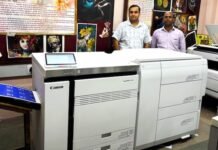During Indian Printer & Publisher’s visit to Lucknow this August, we met quite a few commercial printers. Some of the meetings, however, had to be deferred because of heavy rain. One of them was Ohm Offset, owned and managed by Sachin Bhargava, with whom we could finally connect later on. Sachin is the son of Jawahar Lal Bhargava, owner of Swastik Printers and president of the current Lucknow Printers Association (LPA). Coming from a commercial printing legacy, both Sachin and his younger brother Nitin Bhargava have set up their own establishments in offset and digital, respectively.
In our conversation with Sachin, we learned about his stint in the printing industry, his struggles in creating an identity for himself, and how Ohm Offset will make a move toward digital in January 2025 with the installation of a Konica Minolta press. He explained how without rapid industrialization, the printers of Lucknow would not be able to grow like the pre-pandemic days.
Sachin initially joined the family business for a couple of years after completing his MBA. After learning the ropes of business, he established Ohm Offset in 2013 and installed a 4-color mini offset from Auto Print. The company also owns a couple of Heidelberg offset presses with in-house cutting, binding, and lamination.
“The initial year of the business was scary, I kept wondering if this would sustain. Eventually, we started getting orders from banks, education hubs, and other custom jobs that set us sailing. Till the pandemic, it was all good. With new installations, robust production and supplies, and repeat jobs, growth seemed concrete.”
After the pandemic, several commercial printers shut their production. “According to my estimates, around 60% of businesses shut their shops. The banking sectors decided on a paperless structure and as digital facilities grew, the education sector jobs slowed down. Some printers are adding digital as return on investment on offset is not possible. Additionally, digital provides relief as offset technology comes with additional costs and labor.”
These days, a commercial printer in Lucknow relies solely on job work due to the lack of bulk demand. Government tenders for printing jobs, as Sachin explained, run on a bidding mechanism and only printers with big pockets can get those orders. Small and medium players can’t pitch as high. They, however, have the capacities required for those jobs. The workforce or machine operators are also finding it hard to get jobs.
“There has been at least a 30% reduction in the workforce post-covid,” he says. “Many of them work as security guards, waiters, street food vendors, and, in some cases, go back to their native places. Uttar Pradesh is waiting for opportunities to grow both profitably and technologically. The entire printing landscape changed after the pandemic.”
He said even those with capital are not inclined toward commercial printing these days. So what would make it better? Sachin said, “A little support from the government would be nice. It is a cost-sensitive market and as such retaining profit margins is a herculean task. Even during elections, parties reduce pamphlets and poster orders to cut costs. If the printers could get better subsidies or even some repeat tenders, it could help the businesses to stay afloat.”
According to him, rapid industrialization could also be a solution. However, the lack of industries is a significant challenge. A shift toward packaging is not possible as there is no demand in Lucknow. Kanpur, he said, has come out as a stronger front for packaging in comparison.
“It is easier to foray towards packaging in tier 1 cities as there is demand and consumption. In places with no demand, where every rejection amounts to a loss, there is little hope,” he adds.

















